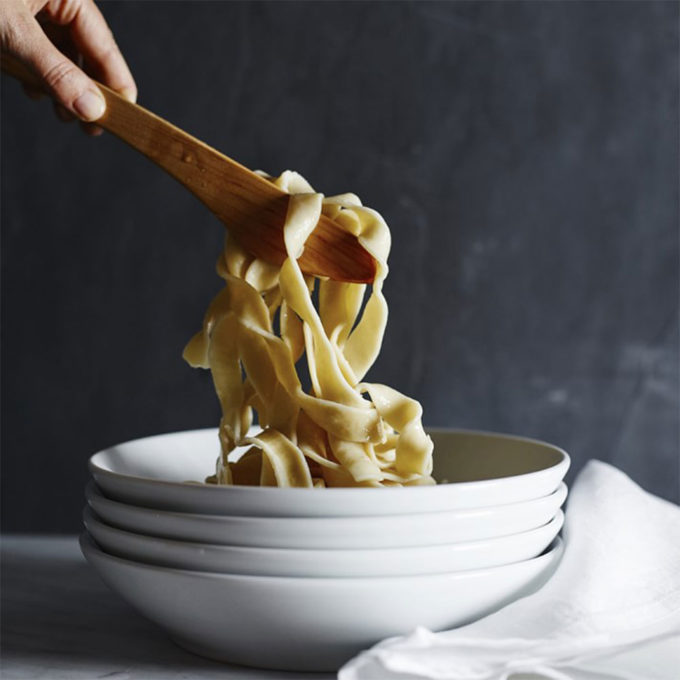
How to Make Pasta From Scratch
Making pasta from scratch is easier than you may think. And not only will you be able to taste the difference in the finished product, you’ll also know exactly what ingredients went into it.
Here, we demonstrate two ways to make fresh pasta: by machine and by hand. The first is faster, but it requires special equipment; the second is a labor of love, ideal for a leisurely weekend or group activity. Either way, you’ll be rewarded with flavorful, slightly chewy strands made with just flour, eggs, olive oil and a pinch of salt — the perfect foundation for any pasta dish. Start with the basic recipe below, then read on for step-by-step instructions. And, when your work is done, check our website for the more than 300 pasta recipes we have to share with you.
What Type of Flour is Used to Make Pasta
- All-Purpose Flour – very common and easily accessible
- Semolina – great for making pasta that will cling to sauces
- “00” Flour – able to create a silky texture for homemade pasta
Fresh Egg Pasta Recipe
Makes 1 lb. (500 g.)
Ingredients
- 2 1/2 cups (12 1/2 oz./390 g.) unbleached all-purpose or “00” flour, plus more flour as needed
- 1/4 tsp. fine sea salt
- 4 large eggs, at room temperature
- 2 tsp. olive oil
Making Pasta By Machine
Instructions
1. Mix the flour. Fit a food processor with the metal blade. Add all but 1/2 cup (2 1/2 oz./75 g.) of the flour and the salt to the food processor work bowl and pulse to mix. Set the reserved 1/2 cup flour aside; you will use it later to adjust the consistency of the dough.
2. Add the eggs and oil. Crack the eggs into a liquid measuring cup and check for and remove any stray shells. Add the oil; there is no need to stir. Pour the eggs and oil into the food processor work bowl.
3. Mix the dough. Process until the flour is evenly moistened and crumbly, about 10 seconds. Test the dough by pinching it; if it is very sticky, add more flour, 1 tablespoon at a time, processing until it is incorporated. After about 30 seconds total, the dough should come together in a loose ball and feel moist but not sticky.
4. Flour a work surface. Dust a clean work surface with flour. Remove the ball of dough from the food processor and place it in the center of the floured surface. Using your hands, flatten the dough into a disk.
5. Knead the dough. Using the heel of your hand, push the dough down and away from you, fold in half back toward you, rotate a quarter turn, and repeat the kneading motion. After about 10 minutes, the dough should be smooth and elastic.
6. How long to rest pasta dough? Shape the dough into a ball, cover with an overturned bowl, and let rest for 15 minutes before you roll it out. The gluten in the flour will relax, making the dough easier to roll. Do not let it rest longer or it will be too dry.
7. Set up the machine. Set up the pasta machine according to the manufacturer’s directions. Set the rollers at the widest setting and dust with flour to prevent sticking. Cut the dough into 4 equal pieces and slip 3 pieces back under the bowl.
8. Knead the dough. Flatten the remaining piece into a disk and dust with flour. Turning the crank, feed the dough through the rollers. Fold the dough into thirds like a letter. Lightly flour both sides and feed it through again; this process further kneads the dough. Repeat the folding and rolling twice, dusting with flour as needed.
9. Roll out the dough. Narrow the rollers to the next notch, dust the dough with flour, and pass it through the rollers again. Catch the sheet with your hand and carefully guide it onto the work surface. Narrow the rollers to the next notch and feed the dough through again. If the dough tears, start again at the widest setting.
10. Roll out thinner. Continue in this fashion, dusting with flour and repairing holes as needed. For tagliatelle, pappardelle, taglierini and lasagne, end with the narrowest setting (1/32 inch/1 mm). For fettuccine and trenette, stop at the second-to-last notch (1/16 inch/2 mm).
11. Cut into sections. At the end of rolling, you will have a long, smooth sheet 4-5 inches (10-13 cm.) wide from each of the 4 pieces of dough. To cut pasta sheets into strands, place the rolled-out sheets flat on a clean work surface and cut it crosswise into 14-inch (35 cm.) lengths.
12. Cut into strands. Fasten the machine’s cutting attachment and insert the crank. Most standard cutters have two widths, 1/4 inch (6 mm.) for fettuccine/tagliatelle and 1/16 inch (2 mm.) for taglierini. Feed the pasta sheets through the desired blade and catch gently.
Making Pasta by Hand Without a Machine
1. Make a well. Measure the flour onto a work surface, mix in the salt, and shape the flour into a mound. Using your fingertips, make a well in the center.
2. Add the eggs and oil. Break the eggs into the center of the well and add the oil. Using a fork, beat until the eggs and oil are blended, making sure the liquid doesn’t breach the walls of the well.
3. Draw in the flour. Using the fork, gradually draw the flour from the sides of the well into the egg mixture and beat gently, always in the same direction, to combine the flour with the liquid. Secure the wall of the well with your other hand until the liquid has absorbed enough flour that it won’t flow over the wall.
4. Use your hands. When the mixture is too stiff to use the fork, begin using both hands, gradually drawing in the flour from the bottom of the wall, until you have a soft, moist, but not sticky ball of dough. If the dough will not absorb more water without becoming stiff, don’t use it all. If it is too soft, add more flour, a spoonful at a time.
5. Knead the dough. Clean the work surface, dust it lightly with flour, and flatten the ball of dough into a disk. Using the heel of your hand, push the dough down and away from you, fold it in half back toward you, rotate a quarter turn, and repeat the kneading motion.
6. Let the dough rest. Shape the dough into a ball, cover with an overturned bowl, and let rest for 15 minutes before you roll it out. The gluten in the flour will relax, making the dough easier to roll. Do not let it rest longer or it will be too dry.
7. Roll out the dough. Cut the dough into 4 equal pieces and slip 3 pieces back under the bowl. Flatten the remaining piece into a disk and dust with flour. Using a floured rolling pin, roll the dough away from you. Lift the dough, flour the work surface again, if necessary, and turn the dough 90 degrees. Roll out again.
8. Test for thinness. Continue rolling the dough until you can see your hand through it. For tagliatelle, taglierini, pappardelle, stuffed pastas and lasagne, roll out to 1/32 inch (1 mm.) thick. For fettuccine and trenette, roll out to 1/16 (2 mm.) thick. Transfer to a floured baking sheet and let rest for 10-20 minutes.
9. Cut into sections. Place the rolled-out pasta sheet on a clean work surface. Using a pizza cutter or paring knife, cut the pasta sheet into sections 4-5 inches (10-13 cm.) wide and 14 inches (35 cm.) long. You may find it helpful to use a ruler for guidance.
10. Cut strands. On a lightly floured work surface, starting on a short side, roll up a pasta sheet into a loose, flat cylinder. Using a chef’s knife, cut the cylinder crosswise to create strands. To make fettuccine and tagliatelle, cut at about 1/4-inch (6-mm.) intervals. For pappardelle, cut at 3/4-1 inch (2-2.5-cm.) intervals. For trenette, cut just shy of 1/4-inch (6-mm.) intervals. For taglierini, cut at 1/16-inch (2-mm.) intervals. Gently shake out the noodles to separate them.
See more tips for fresh, dried and stuffed pasta in our Pasta Primer.
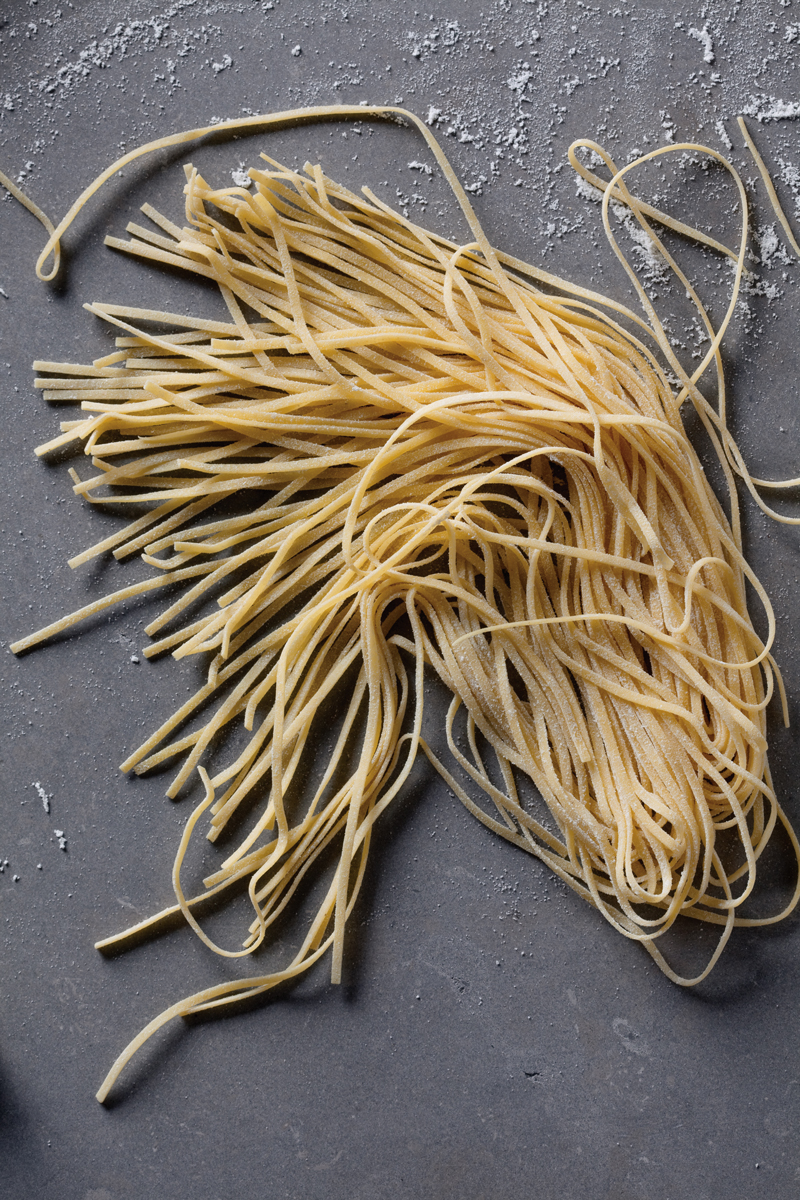




 Based on 14 Review(s)
Based on 14 Review(s)
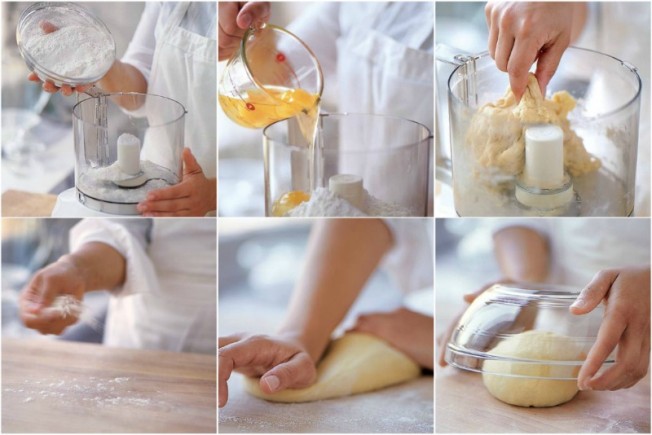
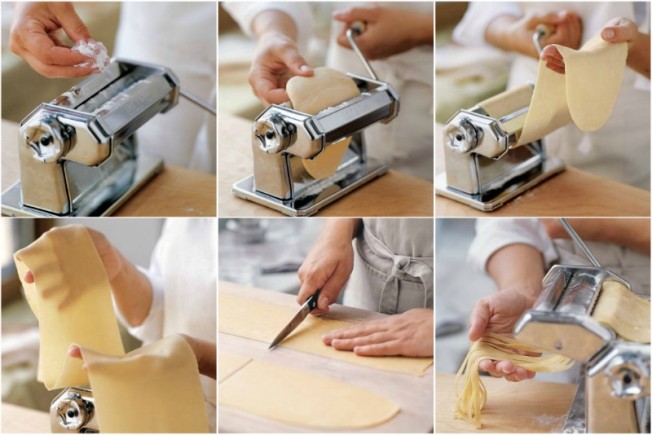
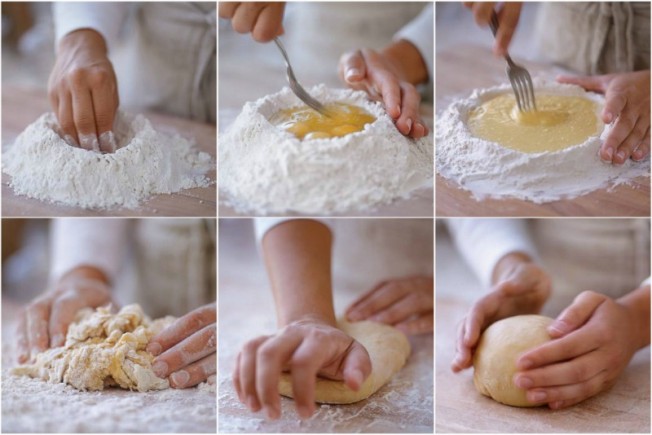
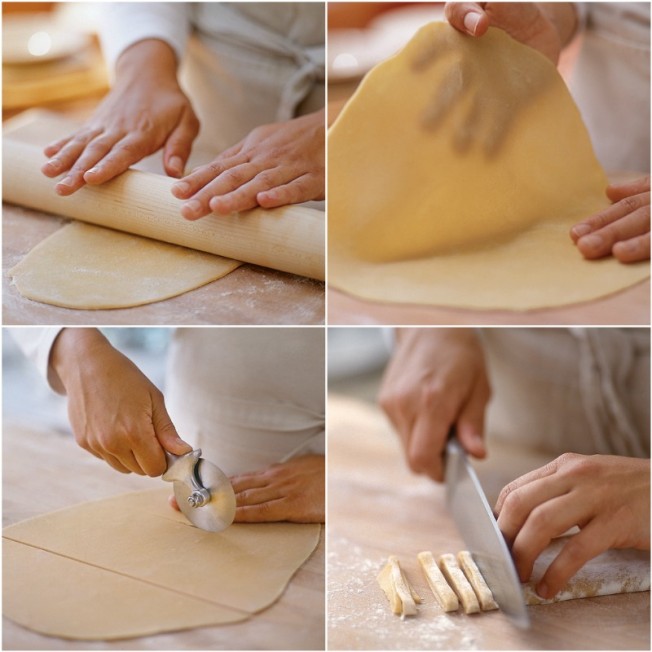
14 comments
most favorite food in the world
I can’t eat white flour for health reason. Do you have a whole wheat option?
How do you cook the pasta once you have made it? Do you cook it like store bought pasta?
As noted earlier, the conversions are all incorrect.
1 ounce = 28.35 grams.
2.5 ounces = 70.9 grams (not 75 grams as stated)
12.5 ounces = 354.4 grams (not 390 grams as stated)
Hi how long should you dry fresh pasta before cooking
[…] the filling recipe, since the noodle making would be pretty lengthy to type out. However, I linked this blog post to show you the recipe we usually follow to make the noodles by […]
I must thank you for the efforts you have put in writing this website.
I’m hoping to view the same high-grade blog posts from you later on as well.
In truth, your creative writing abilities has motivated me to get my very own website now 😉
Can I substitute wheat or spelt flour? thanks
just made pasta for the first time why when after cut layers out flat it all sticks together and yes sprinkled with flour?
If we’re using 2 1/2 cups of all-purpose flour, OR 12 1/2 ounces, shouldn’t it be 355 grams, rather than 390 grams?
Hi T.J., our recipe specifies 390 grams of flour, so that should be correct. Please let us know if you encounter any problems and we’ll look into it further!
Right…what I’m saying is that 12 1/2 ounces is not the same thing as 390 grams. If 12 1/2 ounces is correct, then it should list 355 grams. If 390 grams is correct, it should list 13 3/4 ounces.
I hope I have the nerve to try this!
I love to do this! I hope I have the nerve.